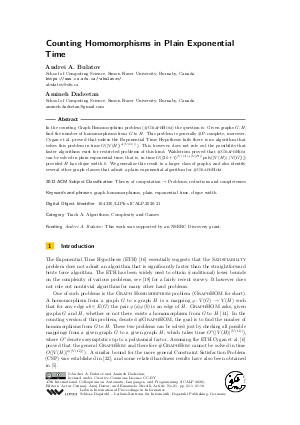Counting Homomorphisms in Plain Exponential Time
Authors Andrei A. Bulatov, Amineh Dadsetan
-
Part of:
Volume:
47th International Colloquium on Automata, Languages, and Programming (ICALP 2020)
Part of: Series: Leibniz International Proceedings in Informatics (LIPIcs)
Part of: Conference: International Colloquium on Automata, Languages, and Programming (ICALP) - License:
 Creative Commons Attribution 3.0 Unported license
Creative Commons Attribution 3.0 Unported license
- Publication Date: 2020-06-29
File

PDF
LIPIcs.ICALP.2020.21.pdf
- Filesize: 0.55 MB
- 18 pages
Document Identifiers
Subject Classification
ACM Subject Classification
- Theory of computation → Problems, reductions and completeness
Keywords
- graph homomorphisms
- plain exponential time
- clique width
Metrics
- Access Statistics
-
Total Accesses (updated on a weekly basis)
0Document
0Metadata
Abstract
In the counting Graph Homomorphism problem (#GraphHom) the question is: Given graphs G,H, find the number of homomorphisms from G to H. This problem is generally #P-complete, moreover, Cygan et al. proved that unless the Exponential Time Hypothesis fails there is no algorithm that solves this problem in time O(|V(H)|^o(|V(G)|)). This, however, does not rule out the possibility that faster algorithms exist for restricted problems of this kind. Wahlström proved that #GraphHom can be solved in plain exponential time, that is, in time O((2k+1)^(|V(G)|+|V(H)|) poly(|V(H)|,|V(G)|)) provided H has clique width k. We generalize this result to a larger class of graphs, and also identify several other graph classes that admit a plain exponential algorithm for #GraphHom.
Cite As Get BibTex
Andrei A. Bulatov and Amineh Dadsetan. Counting Homomorphisms in Plain Exponential Time. In 47th International Colloquium on Automata, Languages, and Programming (ICALP 2020). Leibniz International Proceedings in Informatics (LIPIcs), Volume 168, pp. 21:1-21:18, Schloss Dagstuhl – Leibniz-Zentrum für Informatik (2020)
https://doi.org/10.4230/LIPIcs.ICALP.2020.21
BibTex
@InProceedings{bulatov_et_al:LIPIcs.ICALP.2020.21,
author = {Bulatov, Andrei A. and Dadsetan, Amineh},
title = {{Counting Homomorphisms in Plain Exponential Time}},
booktitle = {47th International Colloquium on Automata, Languages, and Programming (ICALP 2020)},
pages = {21:1--21:18},
series = {Leibniz International Proceedings in Informatics (LIPIcs)},
ISBN = {978-3-95977-138-2},
ISSN = {1868-8969},
year = {2020},
volume = {168},
editor = {Czumaj, Artur and Dawar, Anuj and Merelli, Emanuela},
publisher = {Schloss Dagstuhl -- Leibniz-Zentrum f{\"u}r Informatik},
address = {Dagstuhl, Germany},
URL = {https://drops.dagstuhl.de/entities/document/10.4230/LIPIcs.ICALP.2020.21},
URN = {urn:nbn:de:0030-drops-124287},
doi = {10.4230/LIPIcs.ICALP.2020.21},
annote = {Keywords: graph homomorphisms, plain exponential time, clique width}
}
Author Details
Funding
- Bulatov, Andrei A.: This work was supported by an NSERC Discovery grant.
References
-
László Babai. Graph isomorphism in quasipolynomial time [extended abstract]. In Proceedings of the 48th Annual ACM SIGACT Symposium on Theory of Computing, STOC 2016, Cambridge, MA, USA, June 18-21, 2016, pages 684-697, 2016.

-
Marthe Bonamy, Lukasz Kowalik, Michal Pilipczuk, Arkadiusz Socala, and Marcin Wrochna. Tight lower bounds for the complexity of multicoloring. TOCT, 11(3):13:1-13:19, 2019.

-
Flavia Bonomo, Luciano N. Grippo, Martin Milanic, and Martín Darío Safe. Graph classes with and without powers of bounded clique-width. Discrete Applied Mathematics, 199:3-15, 2016.

-
Andreas Brandstädt, Feodor F. Dragan, Hoàng-Oanh Le, and Raffaele Mosca. New graph classes of bounded clique-width. Theory Comput. Syst., 38(5):623-645, 2005.

-
Jianer Chen, Xiuzhen Huang, Iyad A. Kanj, and Ge Xia. Strong computational lower bounds via parameterized complexity. J. Comput. Syst. Sci., 72(8):1346-1367, 2006.

-
Marek Cygan, Fedor V. Fomin, Alexander Golovnev, Alexander S. Kulikov, Ivan Mihajlin, Jakub Pachocki, and Arkadiusz Socala. Tight bounds for graph homomorphism and subgraph isomorphism. In Proceedings of the Twenty-Seventh Annual ACM-SIAM Symposium on Discrete Algorithms, SODA 2016, Arlington, VA, USA, January 10-12, 2016, pages 1643-1649, 2016.

- Amineh Dadsetan and Andrei A. Bulatov. Counting homomorphisms in plain exponential time. CoRR, abs/1810.03087, 2018. URL: http://arxiv.org/abs/1810.03087.
-
Víctor Dalmau and Peter Jonsson. The complexity of counting homomorphisms seen from the other side. Theor. Comput. Sci., 329(1-3):315-323, 2004.

-
Martin E. Dyer and Catherine S. Greenhill. The complexity of counting graph homomorphisms. Random Struct. Algorithms, 17(3-4):260-289, 2000.

-
Fedor V. Fomin, Serge Gaspers, and Saket Saurabh. Improved exact algorithms for counting 3- and 4-colorings. In Computing and Combinatorics, 13th Annual International Conference, COCOON 2007, Banff, Canada, July 16-19, 2007, Proceedings, pages 65-74, 2007.

-
Fedor V. Fomin, Pinar Heggernes, and Dieter Kratsch. Exact algorithms for graph homomorphisms. Theory Comput. Syst., 41(2):381-393, 2007.

-
Martin Charles Golumbic and Udi Rotics. On the clique-width of some perfect graph classes. Int. J. Found. Comput. Sci., 11(3):423-443, 2000.

-
Martin Grohe. The complexity of homomorphism and constraint satisfaction problems seen from the other side. J. ACM, 54(1):1:1-1:24, 2007.

-
P. Hell and Nešetřil. Graphs and homomorphisms, volume 28 of Oxford Lecture Series in Mathematics and its Applications. Oxford University Press, 2004.

-
P. Hell and J. Nešetřil. On the complexity of H-coloring. Journal of Combinatorial Theory, Ser.B, 48:92-110, 1990.

-
Russell Impagliazzo and Ramamohan Paturi. Complexity of k-SAT. In Proceedings of the 14th Annual IEEE Conference on Computational Complexity, Atlanta, Georgia, USA, May 4-6, 1999, pages 237-240, 1999.

-
Mikko Koivisto. An O^*(2ⁿ) algorithm for graph coloring and other partitioning problems via inclusion-exclusion. In 47th Annual IEEE Symposium on Foundations of Computer Science (FOCS 2006), 21-24 October 2006, Berkeley, California, USA, Proceedings, pages 583-590, 2006.

-
Daniel Lokshtanov, Dániel Marx, and Saket Saurabh. Lower bounds based on the exponential time hypothesis. Bulletin of the EATCS, 105:41-72, 2011.

-
László Lovász. Kneser’s conjecture, chromatic number, and homotopy. J. Comb. Theory, Ser. A, 25(3):319-324, 1978.

-
Johann A. Makowsky and Udi Rotics. On the clique-width of graphs with few P4’s. International Journal of Foundations of Computer Science, 10(03):329-348, 1999.

- Jesper Nederlof. Inclusion exclusion for hard problems. Master’s thesis, Department of Information and Computer Science, Utrecht University, 2008. URL: http://www.win.tue.nl/jnederlo/MScThesis.pdf.
-
Patrick Traxler. The time complexity of constraint satisfaction. In Parameterized and Exact Computation, Third International Workshop, IWPEC 2008, Victoria, Canada, May 14-16, 2008. Proceedings, pages 190-201, 2008.

-
Magnus Wahlström. New plain-exponential time classes for graph homomorphism. In Computer Science - Theory and Applications, Fourth International Computer Science Symposium in Russia, CSR 2009, Novosibirsk, Russia, August 18-23, 2009. Proceedings, pages 346-355, 2009.

